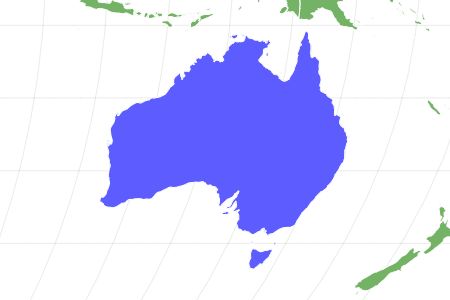High energy levels and active minds!
Advertisement
Australian Cattle Dog Scientific Classification
- Kingdom
- Animalia
- Phylum
- Chordata
- Class
- Mammalia
- Order
- Carnivora
- Family
- Canidae
- Genus
- Canis
- Scientific Name
- Canis lupus
Read our Complete Guide to Classification of Animals.
Australian Cattle Dog Conservation Status
Australian Cattle Dog Facts
- Temperament
- Strong minded yet loyal and loving
- Training
- Should be trained from an early age and respond best to firm and fair training
- Diet
- Omnivore
- Average Litter Size
- 5
Australian Cattle Dog as a Pet:
- General Health
- Energy Level
- Shedability
- Trainability
- Intelligence
- Tendency to Chew
- Size
- Family and kid friendliness
- Yappiness / Barking
- Low
- Separation Anxiety
- Moderate
- Preferred Temperature
- Average climate
- Exercise Needs
- High
- Friendly With Other Dogs
- High
- Pure bred cost to own
- $600
- Dog group
- Herding
- Male weight
- -45 lbs
- Female weight
- -45 lbs
This post may contain affiliate links to our partners like Chewy, Amazon, and others. Purchasing through these helps us further the A-Z Animals mission to educate about the world's species.
View all of the Australian Cattle Dog images!
Australian cattle dogs are loyal, energetic, and friendly. This dog, also known as a red or blue heeler, is intelligent with a curious mind. Their intelligence makes them easy to train. These are just a few of the reasons why this breed is a popular family dog.
These herding dogs were first bred in Australia in the 1800s. An Australian cattle dog is the result of breeding a blue merle collie with a dingo. They were bred to herd livestock.
See all of our expert product reviews.
The large, pointed ears of this dog as well as its dark eyes make it an endearing addition to any household. Keep in mind these are social dogs that like to be with family members or other pets at all times.
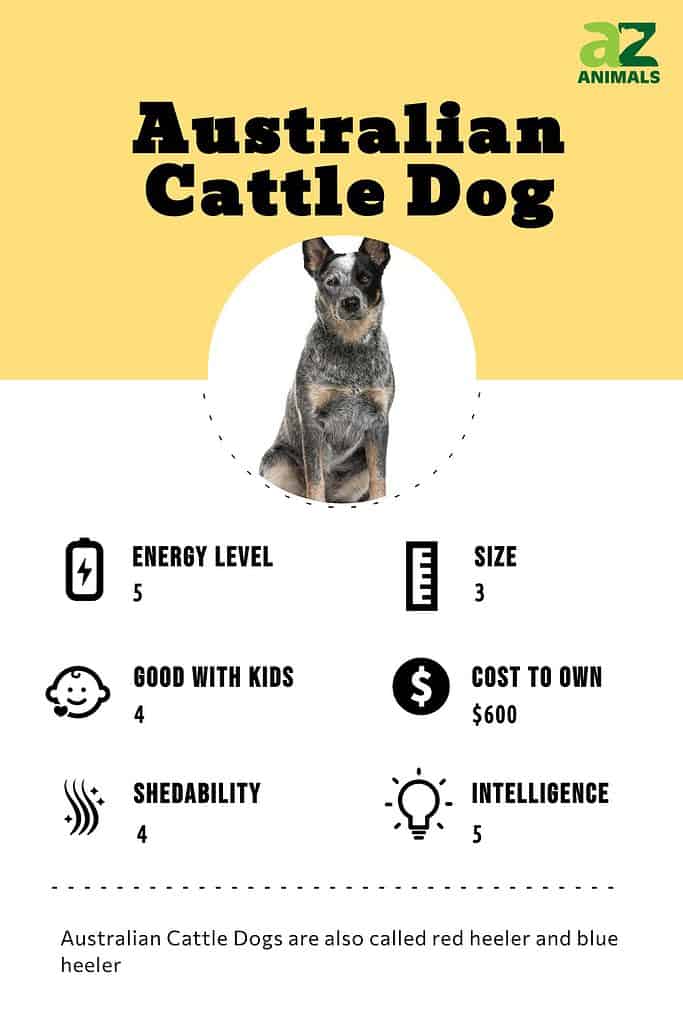
3 Pros and Cons of Owning an Australian Cattle Dog
| Pros! | Cons! |
| A very loyal dog Australian cattle dogs become very attached to their families. This makes them welcome companions. | Unhappy when left alone These dogs are social and don’t like to be left alone for long periods of time. In fact, they can become destructive if left by themselves. |
| Very little barking These dogs don’t bark a lot. So, a family that wants a dog that is quiet (but not still) most of the time is going to appreciate a red or blue heeler. | Needs daily exercise Whether it’s a red or blue heeler, these dogs need exercise every day. |
| Pet friendly They are known for getting along with other dogs in a household. | Not an apartment dog The high energy level of these dogs means they need a lot of space to move around in. They aren’t a good choice for apartment life. |
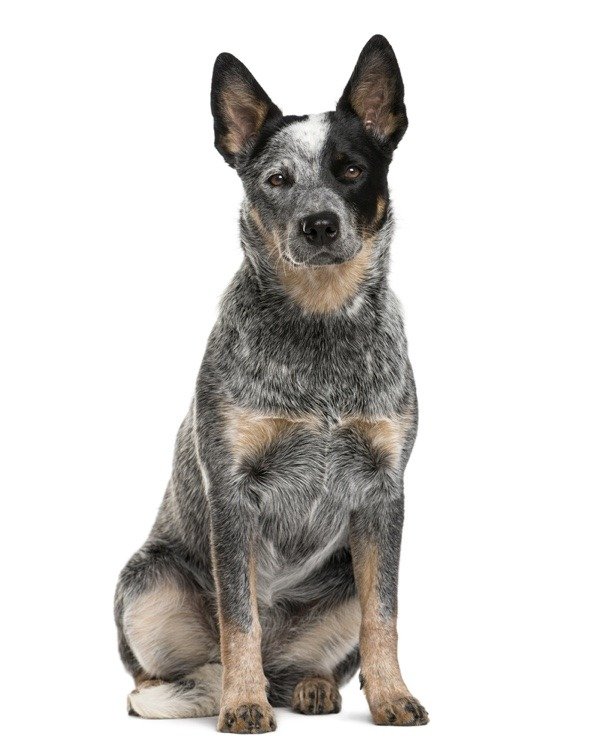
©Eric Isselee/Shutterstock.com
History and Origins
The Australian Cattle Dog played an important role in the development of the beef industry in Australia, which was a significant part of the economy. In the early 1800s, people from Britain began to move away from the original settlements along the coast and into the grassy plains of the western inland. This area was ideal for raising cattle, so herding dogs were needed to help make it possible.
In the beginning, Australian livestock owners imported British Smithfield dogs, but these breeds were not suitable for the hot weather, rough terrain, and long travel times to market in their new homes. Therefore, ranchers began a lengthy effort to create a herding dog that could handle the conditions of the Australian outback. To do this, Smithfields were bred with Dingoes and other breeds like Scottish Highland Collies. As a result, farmers developed the strong and reliable herding dogs they desired.
Health and Entertainment for your Australian Cattle Dog
See all of our expert product reviews.
George Elliot from Queensland was a major contributor to the development of the Australian Cattle Dog, as he bred Dingoes with Collies and sold the puppies to farmers. This created a dog that was close to being the ideal herding dog for Australia. Later, Jack and Harry Bagust refined the breed even more by mixing in Dalmatians, and a sheepdog called the Black and Tan Kelpie. This combination of breeds produced the ACD that we know today.
The Australian Cattle Dog was accepted into the American Kennel Club in 1980 and became a founding member of the Herding Group when it was established in 1983.
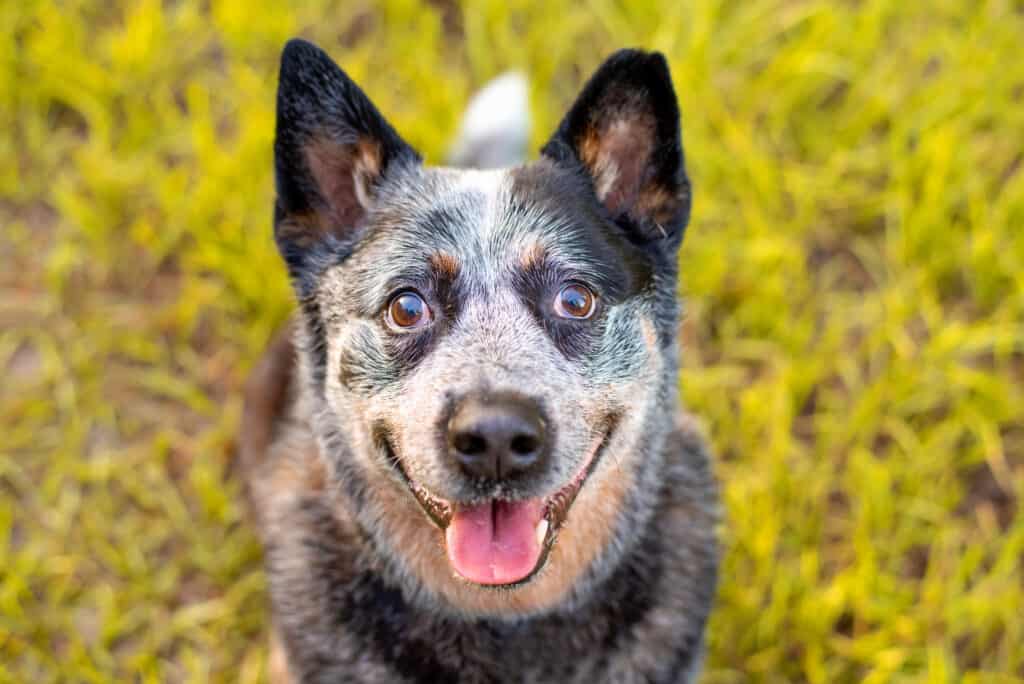
The Australian Cattle Dog was accepted into the AKC in 1980
©iStock.com/Tatyana Consaul
Size and Weight
This is a medium-sized breed with short hair. The average height of a male is 19 inches, while a female is 18 inches tall at the withers. Both males and females weigh 45 pounds when fully grown at 16 months. An 8-week-old puppy should weigh 10.5 pounds.
The record for the oldest Australian cattle dog is held by Bluey, who lived to be 29 years old.
| Height | Weight | |
| Male | 19 inches | 18 inches |
| Female | 45 lbs (fully grown) | 45 lbs (fully grown) |
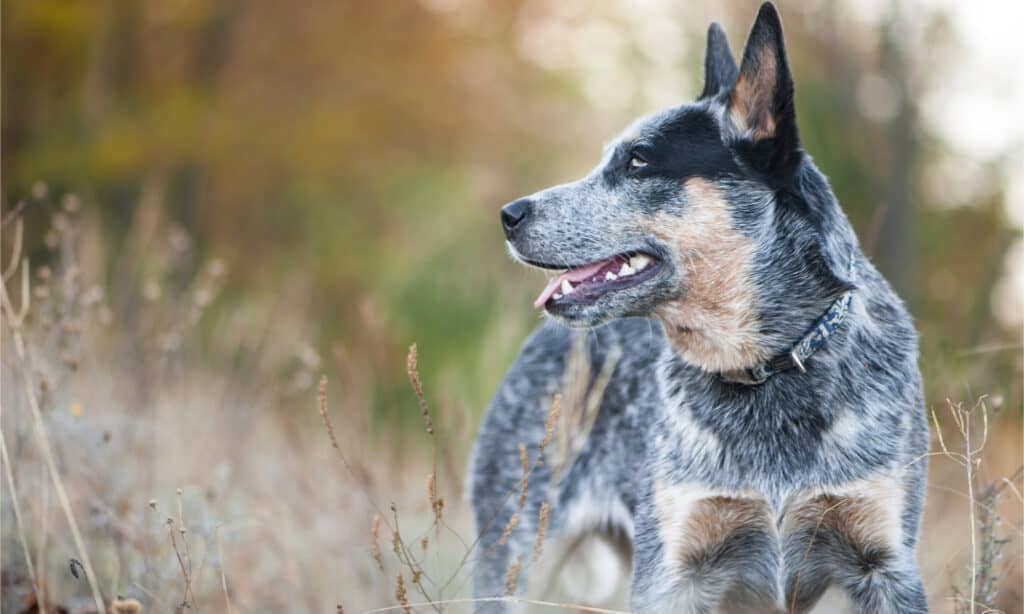
Australian cattle dogs weigh about 45 pounds when fully grown.
© Iryna Dobrovynska/Shutterstock.com
Common Health Issues
Progressive retinal atrophy is a common health issue of this dog. This is a degenerative disease that affects the photoreceptor cells in the eye. It is a genetic condition and can lead to blindness. Hip dysplasia is another common health issue. The hip joint consists of a ball and socket. When a dog develops hip dysplasia, the ball and socket don’t fit together in the right way. Over time, this inherited condition causes deterioration of the hip joint. A third common health issue is elbow dysplasia. This genetic condition involves abnormal cell growth. It causes malformation of the elbow joint. Elbow dysplasia may not appear in a dog until it’s at least 4 months old.
The most common health issues for an Australian cattle dog are:
- Progressive retinal atrophy
- Hip dysplasia
- Elbow dysplasia
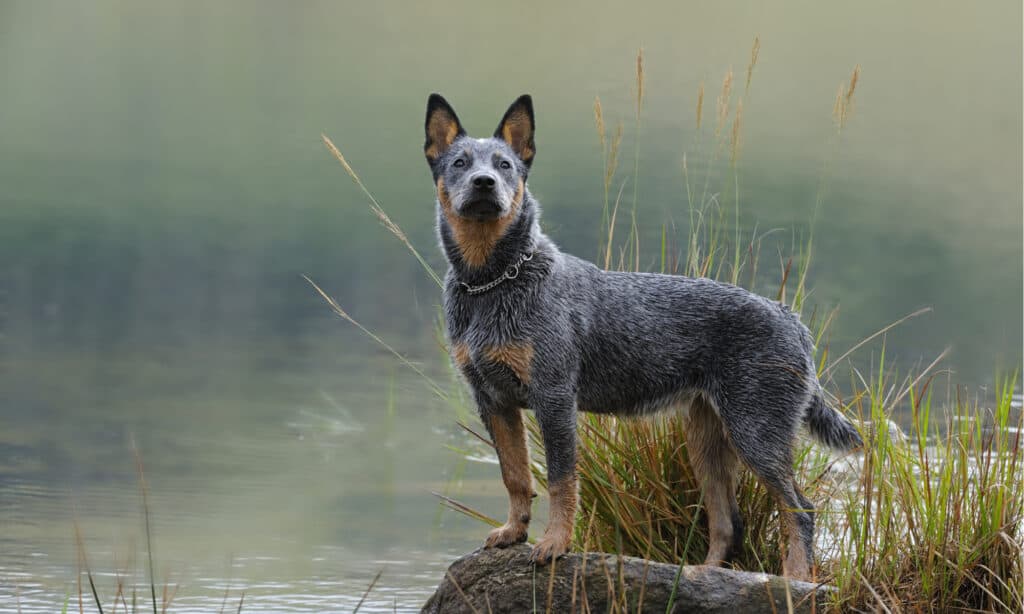
Australian cattle dogs are prone to eye health issues and blindness.
©WOLF AVNI/Shutterstock.com
Temperament and Behavior
Energetic is the best word to describe the behavior of this breed. This is a working dog bred to herd cattle, sheep, or any other livestock. A family with children is going to have a loyal, entertaining pet.
This dog has a friendly personality. They love to be around humans and other pets.
One of its most notable traits is its intelligence. They were bred to handle herding responsibilities. Their intelligence makes obedience training relatively simple.
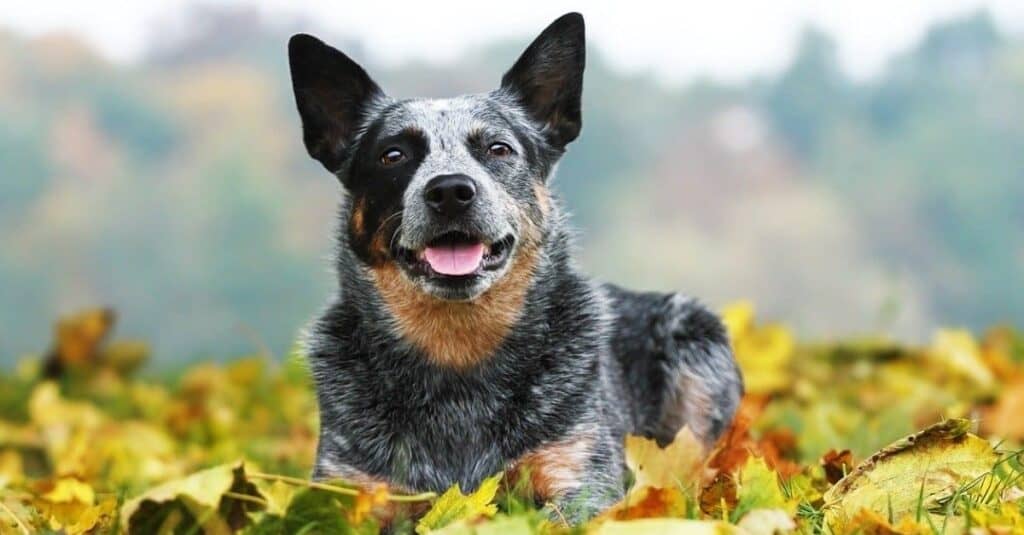
The Australian cattle dog is also known as a blue heeler.
©iStock.com/Carmelka
How to Take Care of an Australian Cattle Dog
When caring for this breed, there are certain things to keep in mind. Giving a red or blue heeler the proper diet, grooming, exercise, etc., can help to keep it in good health. Factoring common health issues into its care can also contribute to the well-being of a puppy or adult dog.
The Best Dog Food
Not surprisingly, puppies need a different type of care than adult dogs.
Puppy food: This breed of puppy needs food high in protein. This ingredient supports the activity of this highly energetic dog. Fiber contributes to a puppy’s digestive health, and fatty acids support skin and coat health. Vitamin A supports healthy retinal function, which can protect against progressive retinal atrophy. Calcium and vitamin D are nutrients that help a puppy guard against hip dysplasia.
Dog food: Just as puppies need protein, so do adults. This nutrient contributes to a dog’s muscle health. Food with a small percentage of carbohydrates gives an adult dog energy while not causing excess weight gain. Vitamins A and C support eye health and provide antioxidants to guard against disease. Calcium keeps bones and joints strong, which can help to prevent hip and elbow dysplasia.
Your Australian Cattle Dog needs well-balanced food to fuel all that energy and joyful activity. That’s why A-Z Animals thinks the best food for Australian Cattle Dogs is Blue Buffalo Wilderness High Protein, Natural Adult Dry Dog Food. If you want to read more, have a look at the complete list of food for you Blue Heeler that we compiled.
In addition to providing a healthy balance of protein and carbohydrates to satisfy non-stop Australian Cattle Dogs’ appetite and build lean muscle, this food also has just enough calcium and phosphorus for strong bones, teeth, and cartilage. There’s glucosamine and vitamin A, too, so elbow/hip dysplasia and eye problems will be less likely to slow your Australian Cattle Dog down.
Check Chewy or Amazon for this product.
- Contains real chicken, sweet potatoes, and peas
- Added omega-3 and omega-6 fatty acids, and antioxidants
- High protein option, best for active dogs
- Made from the finest natural ingredients
Maintenance and Grooming
How much does a red or blue heeler shed? These dogs have short-haired, double coats, so they’re moderate to heavy shedders. A proper grooming routine can reduce the amount of loose dog hair around a home.
This dog requires weekly brushing. A soft brush with boar hair bristles is a great tool to use. Start at the dog’s head and brush toward its tail, following the natural direction of its coat. A grooming glove is an effective tool for the dog’s legs and tail.
It’s a good idea to bathe this dog once per month to remove odors and dirt from its coat. The hair of an Australian cattle dog’s coat resists moisture, so it will dry quickly.
Fur loss or irritated skin due to the presence of fleas or mites are also common afflictions.
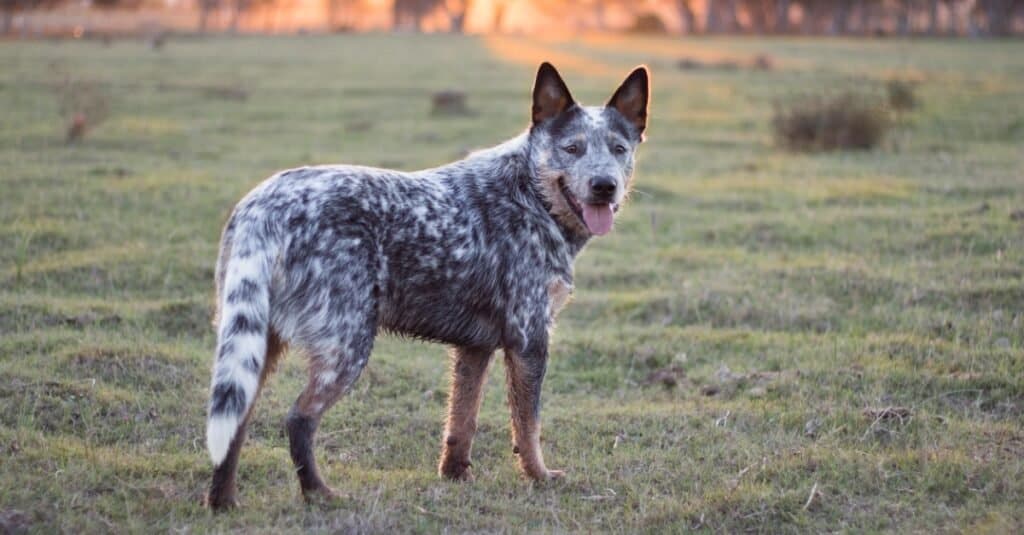
The Australian cattle dog has a double coat that requires regular grooming.
©iStock.com/Madelein_Wolf
Training
This herding dog is smart and a quick learner. So, training is a relatively easy process. One thing to keep in mind is these dogs can have an independent streak. They share this trait with border collies. Australian cattle dogs are the boss of the herds they are moving along. So, sometimes, they try to be the boss of a household. This makes it all the more essential that an owner establishes who is boss during training. As with any other lesson, these dogs are quick to catch on! Using treats during training is helpful in making sure lessons are effective.
Exercise
These dogs have a lot of energy. So, they need exercise at least one hour per day. It’s best to give them a lot of space to run and play. Just think, this working dog was bred to run through acres and acres of fields following herds of sheep or cattle. They need space to stretch their legs. This is part of the reason why they are not appropriate pets for people who live in apartments. A large yard, a big, enclosed field, or a park are all good places to take this dog. Exercise isn’t a luxury. It contributes to their overall health.
Fetch, pulling a rope, frisbee, rolling a ball, or playing chase are just a few of the games these dogs enjoy. A large dog park is another fun place to take an Australian cattle dog.
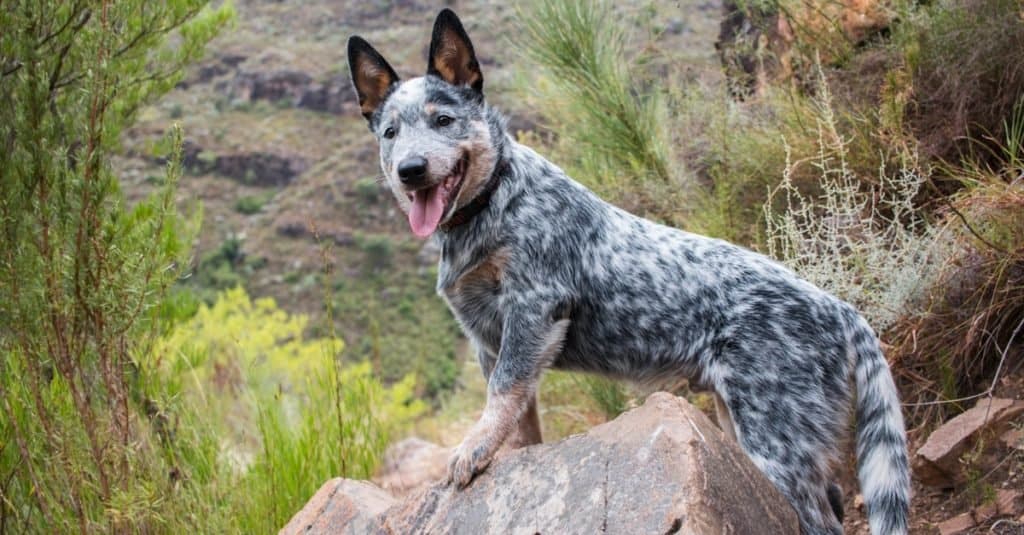
An Australian Cattle Dog has a high need for exercise daily.
©Madelein Wolfaardt/Shutterstock.com
Puppies
Puppies of this breed grow to be fairly large in a short amount of time. They weigh 10.5 pounds at eight weeks. So, these puppies need a lot of space for exercising and growing right from the start. Plus, they are the most ideal choice for a family. These are social puppies/dogs that like to be with family members.
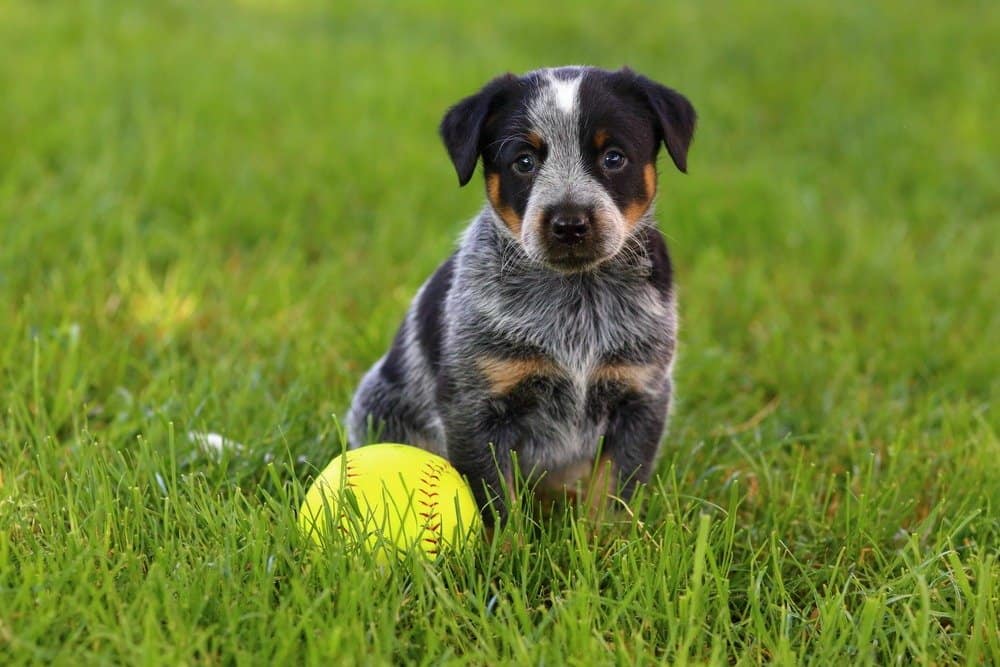
©JLSnader/Shutterstock.com
With Children
Though this dog is a good choice for families with children, there are some things to bear in mind. This is a working dog at heart. They were bred for herding. So, it’s in their DNA to herd things even if there are no cattle or sheep around. Part of their herding behavior is to nip at the heels of the livestock. Some Australian cattle dogs may try this with children as they run through the yard. Training can help with this behavior. Also, if a family is able to get an Australian cattle puppy, it’ll grow up knowing how to behave around young children.
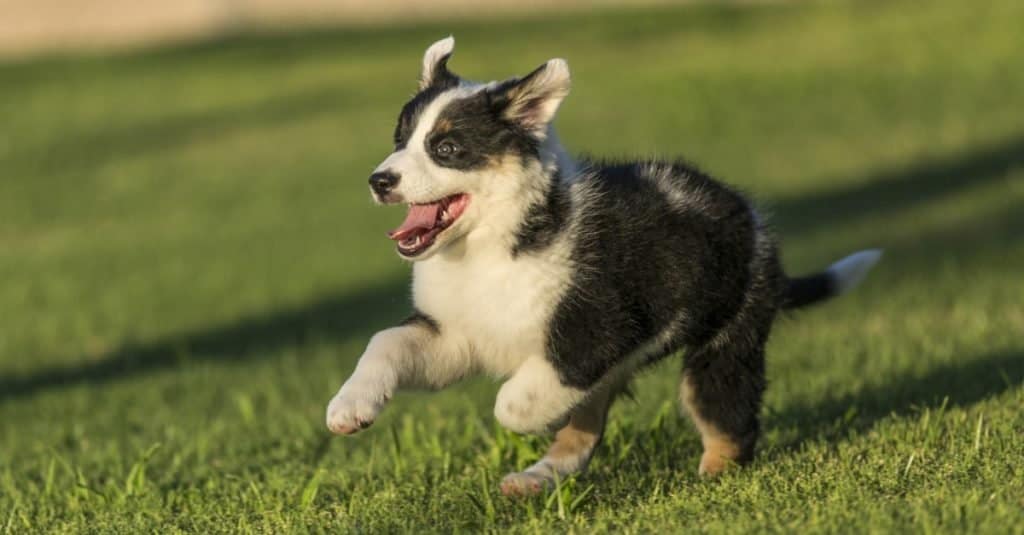
Australian Cattle Dogs are herding dogs. They will often herd children playing in the yard.
©Chris Curtis/Shutterstock.com
Dogs Similar to the Australian Cattle Dog
Some dogs that are similar to Australian cattle dogs include Border collies, Welsh Corgis, and German Shepherds.
- Border collies: This is another herding dog with the same intelligence and alertness as an Australian cattle dog. It’s also easy to train.
- Welsh Corgis: The body of a Welsh Corgi is muscular and compact like the Australian cattle dog. It’s also known for its intelligence and focus.
- German Shepherd: Another energetic dog with intelligence and loyalty. Both this dog and the Australian cattle dog have pointed ears that are always listening.
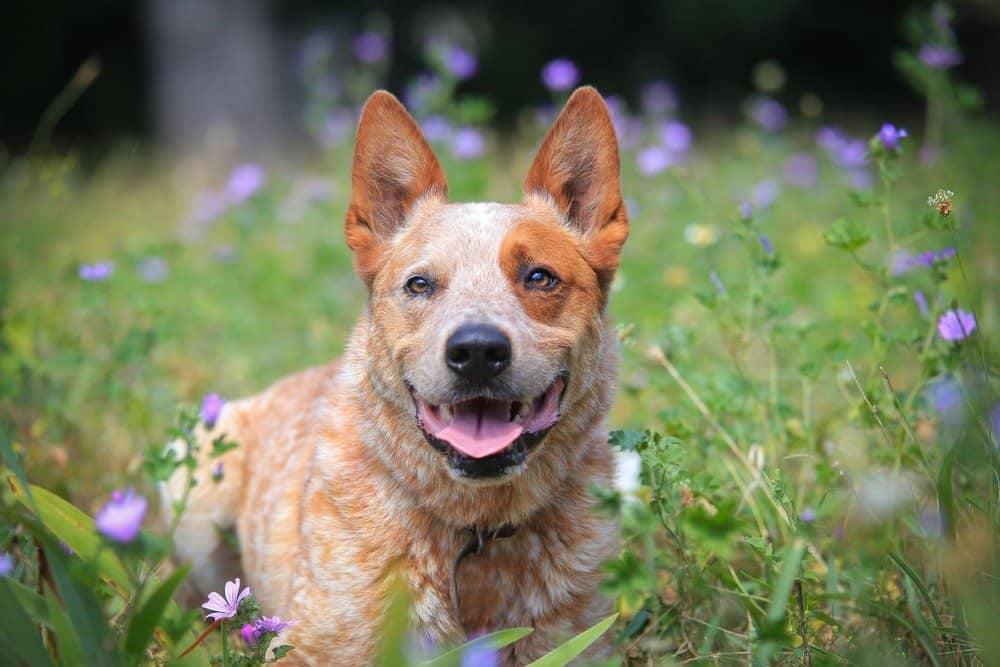
Australian cattle dogs are not always blue. They also come in red and red-speckled.
©Melounix/Shutterstock.com
Australian Cattle Dogs vs the Blue Heeler
The red and blue heeler are the two types of Australian cattle dog. The blue heeler got its name from the blue tone of its coat, while a red heeler has a reddish tint to its fur. Both dogs are the result of breeding a blue merle collie and a dingo in Australia. There’s no difference between the red and blue heelers besides the coat color.
Famous Australian Cattle Dogs
Australian cattle dogs are a favorite pet of some famous individuals, whether they’re native to Australia or not.
- Actor Mel Gibson owns an Australian cattle dog
- Actor Matthew McConaughey owns one
- Actor Owen Wilson owns one named Marley
Popular Names
Popular names for Australian cattle dogs include:
- Apples
- Banjo
- Canberra
- Dingo
- Hugh
- Joey
- Kookaburra
Australian Cattle Dog FAQs (Frequently Asked Questions)
How much does an Australian cattle dog cost to own?
The average cost of a purebred Australian cattle dog is $600. Vet costs range from $200 to $600 annually depending on its overall health. The food bill for this dog ranges around $100 per month depending on the brand of dog food.
Is an Australian cattle dog good with kids?
Yes, if it grows up alongside young kids and has training to teach it how to interact with younger family members.
How long does an Australian cattle dog live?
Normally, the lifespan of this dog is 13 to 15 years.
Is an Australian cattle dog a good family dog?
Yes. It’s best to bring a puppy into a family with young children so the dog learns early on how to interact with young ones.
How big do Australian cattle dogs get?
Male Australian cattle dogs grow to 19 inches tall at the withers while females grow to be 18 inches tall. Both male and females weigh around 45 pounds.
Can Australian cattle dogs be left alone?
They can be left alone. But, these dogs are social and would rather be with people.
What does an Australian cattle dog look like?
Both the red and blue heelers have a muscular, compact body. Red heelers have a tan coat with a reddish tint while a blue heeler has a blue mottled coat with a tan belly. Some blue heelers have faces that are half blue speckled, half white. Both types of Australian cattle dogs have pointed ears, a long fluffy tail and searching dark eyes.
Is the Australian cattle dog the same as a blue heeler?
Yes. A blue heeler is just one of the two types of Australian cattle dog.
Are Australian Cattle Dogs herbivores, carnivores, or omnivores?
Australian Cattle Dogs are Omnivores, meaning they eat both plants and other animals.
What Kingdom do Australian Cattle Dogs belong to?
Australian Cattle Dogs belong to the Kingdom Animalia.
What class do Australian Cattle Dogs belong to?
Australian Cattle Dogs belong to the class Mammalia.
What phylum to Australian Cattle Dogs belong to?
Australian Cattle Dogs belong to the phylum Chordata.
What family do Australian Cattle Dogs belong to?
Australian Cattle Dogs belong to the family Canidae.
What order do Australian Cattle Dogs belong to?
Australian Cattle Dogs belong to the order Carnivora.
What genus do Australian Cattle Dogs belong to?
Australian Cattle Dogs belong to the genus Canis.
What type of covering do Australian Cattle Dogs have?
Australian Cattle Dogs are covered in Hair.
How many babies do Australian Cattle Dogs have?
The average number of babies an Australian Cattle Dog has is 5.
What is an interesting fact about Australian Cattle Dogs?
Australian Cattle Dogs have high energy levels and active minds!
What is the scientific name for the Australian Cattle Dog?
The scientific name for the Australian Cattle Dog is Canis lupus.
What's the difference between a Blue Heeler and an Australian Shepherd?
There are many differences between a Blue Heeler and an Australian Shepherd. Blue Heelers have dense and thick fur, while Australian Shepherds have fluffy coats. The Australian Shepherd also lives longer than Blue Heelers on average.
What are the key differences between Border Collies and Australian Cattle Dogs?
The key differences between Border Collies and Australian Cattle Dogs are appearance, temperament, trainability, and health.
What are the key differences between a Catahoula Leopard Dog and an Australian Cattle Dog?
The key differences between a Catahoula Leopard Dog and an Australian Cattle Dog are size, coat, temperament, health issues, and training.
What are the key differences between Catahoula Leopard Dogs and Blue Heelers?
The key differences between Catahoula Leopard Dogs and Blue Heelers are appearance, coat, temperament, health issues, exercise, and training.
What are the key differences between the Texas Heeler and Blue Heeler?
The largest difference between the Texas Heeler and Blue Heeler is that the Blue Heeler is purebred, while the Texas Heeler is a cross between the Australian Cattle Dog and Australian Shepherd. Other distinguishing traits include their size, appearance, temperament, trainability, barking level, and grooming frequency.
Thank you for reading! Have some feedback for us? Contact the AZ Animals editorial team.
Sources
- Vet Street, Available here: http://www.vetstreet.com/dogs/australian-cattle-dog
- American Kennel Club, Available here: https://www.akc.org/dog-breeds/australian-cattle-dog/
- Cattle Dog World, Available here: https://cattledogworld.com/australian-cattle-dog-history/

